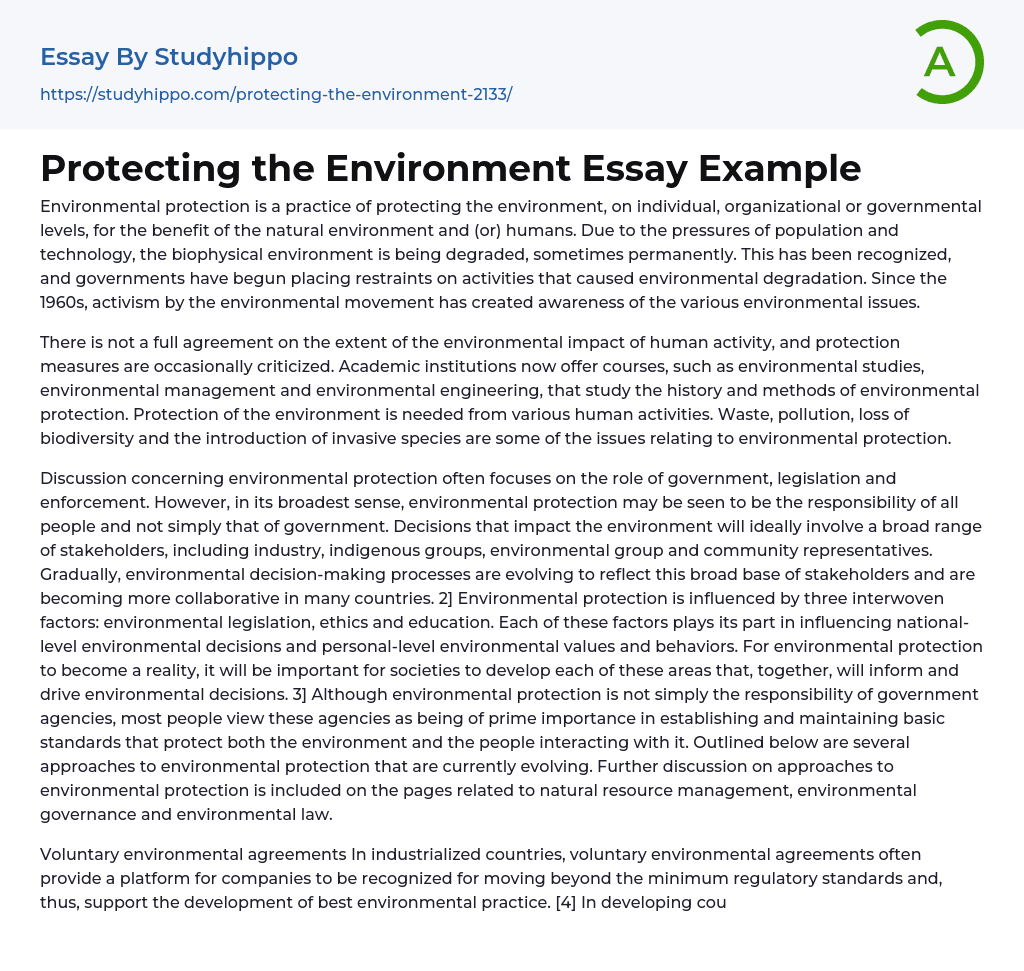Environmental protection is a practice of protecting the environment, on individual, organizational or governmental levels, for the benefit of the natural environment and (or) humans. Due to the pressures of population and technology, the biophysical environment is being degraded, sometimes permanently. This has been recognized, and governments have begun placing restraints on activities that caused environmental degradation. Since the 1960s, activism by the environmental movement has created awareness of the various environmental issues.
There is not a full agreement on the extent of the environmental impact of human activity, and protection measures are occasionally criticized. Academic institutions now offer courses, such as environmental studies, environmental management and environmental engineering, that study the history and methods of environmental protection. Protection of the environment is needed from various human activities. Waste, pollution, loss of biodiversity and the introduction of invasive specie
...s are some of the issues relating to environmental protection.
Discussion concerning environmental protection often focuses on the role of government, legislation and enforcement. However, in its broadest sense, environmental protection may be seen to be the responsibility of all people and not simply that of government. Decisions that impact the environment will ideally involve a broad range of stakeholders, including industry, indigenous groups, environmental group and community representatives. Gradually, environmental decision-making processes are evolving to reflect this broad base of stakeholders and are becoming more collaborative in many countries. 2] Environmental protection is influenced by three interwoven factors: environmental legislation, ethics and education. Each of these factors plays its part in influencing national-level environmental decisions and personal-level environmental values and behaviors. For environmental protection to become a reality, it will be important for societies to develop each o
these areas that, together, will inform and drive environmental decisions. 3] Although environmental protection is not simply the responsibility of government agencies, most people view these agencies as being of prime importance in establishing and maintaining basic standards that protect both the environment and the people interacting with it. Outlined below are several approaches to environmental protection that are currently evolving. Further discussion on approaches to environmental protection is included on the pages related to natural resource management, environmental governance and environmental law.
Voluntary environmental agreements In industrialized countries, voluntary environmental agreements often provide a platform for companies to be recognized for moving beyond the minimum regulatory standards and, thus, support the development of best environmental practice. [4] In developing countries, such as throughout Latin America, these agreements are more commonly used to remedy significant levels of non-compliance with mandatory regulation. [5] The challenges that exist with these agreements lie in establishing baseline data, targets, monitoring and reporting.
Due to the difficulties inherent in evaluating effectiveness, their use is often questioned and, indeed, the environment may well be adversely affected as a result. The key advantage of their use in developing countries is that their use helps to build environmental management capacity. [6] Ecosystems approach An ecosystems approach to resource management and environmental protection aims to consider the complex interrelationships of an entire ecosystem in decision making rather than simply responding to specific issues and challenges.
Ideally the decision-making processes under such an approach would be a collaborative approach to planning and decision making that involves a broad range of stakeholders across all relevant governmental departments, as well as representatives of industry, environmental groups and community. This approach
ideally supports a better exchange of information, development of conflict-resolution strategies and improved regional conservation. [7] International environmental agreements
Kyoto Protocol Commitment map 2010 Many of the earth’s resources are especially vulnerable because they are influenced by human impacts across many countries. As a result of this, many attempts are made by countries to develop agreements that are signed by multiple governments to prevent damage or manage the impacts of human activity on natural resources. This can include agreements that impact factors such as climate, oceans, rivers and air pollution. These nternational environmental agreements are sometimes legally binding documents that have legal implications when they are not followed and, at other times, are more agreements in principle or are for use as codes of conduct. These agreements have a long history with some multinational agreements being in place from as early as 1910 in Europe, America and Africa. [8] Some of the most well-known multinational agreements include: the Kyoto Protocol, Vienna Convention on the Protection of the Ozone Layer and Rio Declaration on Development and Environment.




